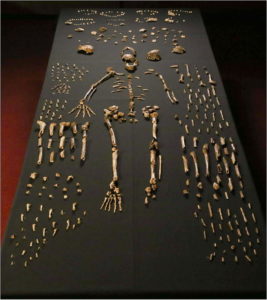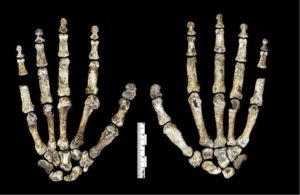Kindred Species: Human Evolution and Missing Links
 Skeletal specimens of Homo naledi (image via Berger Research Team)
Skeletal specimens of Homo naledi (image via Berger Research Team) In his 2009 book, The Greatest Show on Earth: The Evidence for Evolution, biologist Richard Dawkins highlights a conceptual difference between the way anthropologists and biologists interpret the evidence of human evolution. Anthropologists, as Dawkins relates, expend a considerable amount of ink and effort seeking consensus about where exactly the remains or artifacts of a given hominid should be pinned to the evolutionary tree that ends with our own species, homo sapiens sapiens. On occasion these specialists disagree, and a statistical consensus among experts is reached only after great debate and conflict. Of course, in this case “conflict” entails lobbing dry and scholarly but dissenting papers as well as slightly more colorful opinion pieces into each other’s email boxes. On rare but celebrated occasions, they feel obliged to graft a whole new branch onto our family tree. Biologists, on the other hand, recognize that natural selection, operating over millions of years of inheritance and adaptation and millions of square miles of terrain, does not lend itself to easy categorization.
When I was a young man, I remember reading about mysterious “missing links” in the human lineage. This language is typical of poorly written science books (or creationist literature). Evolution occurs across a continuum of beings, not along discreet steps in a linear chain. Minuscule changes accumulated with each passing generation can, in lucky circumstances, confer survival advantages. Sometimes, environmental conditions change radically enough that new adaptations, some of which would have been deleterious just a few generations earlier, confer powerful new selective advantages. Given sufficient time and geography, these adaptations build entirely new species incapable of interbreeding with more distant relatives who did not evolve into new forms.
In this way, entire populations of a given species can persist across geologic time, if they are stable enough within an environmental niche. This more realistic view of evolution explains so-called “living fossils”: organisms like the ginkgo tree, the horseshoe crab, and the famous coelacanth, which still thrive in comfortable niches. These principles also apply to the lineage of humanity. It is a scientific inevitability that a given hominid species, distantly related to some other, would exist contemporaneous with their kin. What may be more surprising is that there aren’t more hominid species around today.
Recent scientific results of radioisotope dating indicate that another hominid species, called Homo naledi, was alive in southern Africa as recently as 300,000 years ago—very nearly contemporaneous with anatomically modern humans, who are thought to have originated somewhere around 200,000 years ago. Anthropologists examining fossil remains of this species found in a cave system outside of Johannesburg, South Africa, conclude that these beings very likely buried their dead (as did the more recent Neanderthals). For some, such discoveries elicit considerations of what it means to be human. Did these beings exhibit compassion? Did they mourn their dead? Did they practice ancestor worship? To what extent did they seek to understand and control their world?
Thus, we must add Homo naledi to a short list of distinctly identified hominids that may have coexisted with our direct ancestors long before recorded history. It is known that our species once shared the planet with close relatives who must have had some of our physical and mental characteristics: Homo floresiensis (the hobbit people discovered in 2003), Homo neaderthalis and Denisovans. There are many unanswered questions about how well (or not) we got along together, and many more about the range of intellectual, cultural, linguistic, and emotional capacities that we might have shared with these kindred beings. For example, a 2013 paper by Eiluned Pearce, Chris Stringer and R.I.M. Dunbar contains the speculation that the small forebrains possessed by Neanderthals (though their brains were larger than ours, overall) hampered their ability to form social connections. This speculation is consistent with the evidence that Neanderthal communities formed smaller social groups than our species did.

Hands of Homo naledi (image via Berger Research Team)
It is sobering and sad to think that there were other intelligent species that we might have helped push toward extinction. How much were these beings like us, and in what ways? Were they sentient moral agents? Considered in the context of evolution, all species of hominids have evolved along branching and often overlapping tracks through time. Just as their physical features evolved, so did their mental capacities. There must have been many paths taken, with different mixtures of ingenuity, compassion, aggression, and social tendencies, exploring and expressing aspects of the vast constellation of human capabilities and dispositions we know of today. Some avenues flourished for a while, perhaps a very long while, but eventually led to incompatibilities with the new world faced by each subsequent generation. Our own place, here and now on a small twig at the edge of the dense branching thicket of life, is the result of the blind, competitive, and random contingencies that have made us who we are. Could it have been different? Absolutely.
Natural selection is capricious and purposeless, and it operates in complete disregard for the sufferings or successes, the failures or desires of any species. Perhaps, hundreds of thousands of years ago, most of humanity also behaved with a disregard for the suffering of other beings or the inherent value of sentient life. We are fortunate, though, to be alive now. This is a time when our minds and our memes—especially regarding moral philosophy—have evolved to be able to consider how we might recognize the humanity of all persons. This is an era when we can countervail the amoral machinations of evolution to bring about a more intentional world; a fairer, more respectful, more prosperous and safer existence for all. Our extinct evolutionary cousins lacked the capacity to recognize and cope with a world changing and becoming more hazardous around them. Perhaps our direct ancestors were part of that hazard. In any case, there are no missing links in the meandering and ever-branching pathways of evolution. There are only results—thousands and millions of glorious resulting species that exist at a given time, in a given world. For the first time, one species—our species—can exert control over our own future. Let’s get it right.
